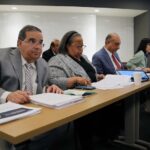By Gloria Petit/@GloriPetit
During her fourth year teaching at Texas A&M University-San Antonio, Pamela Massey discovered that a Powerpoint presentation may not be the only way to teach her students.
At the time, Massey learned that her students weren’t engaging in the law cases important to the history of bilingual education and English as a second language.
In an effort to boost engagement for her students in her course Survey of Bilingual Education class, Massey now requires students to use digital storytelling as a way to help them connect to historical content.
Massey, A&M-San Antonio lecturer and student teacher supervisor for the College of Education, shaped her classroom teaching strategies around the use of technology.
“I found over the course of three years that although [my students] had to research and present in a Powerpoint, they didn’t get that deeper understanding of how important each law case was to providing the necessary support for second language learners,” Massey said.
Three-part series designed to promote collaboration
Massey and sociology professor Vicky Elias presented on new ways to assess students through digital storytelling, the use of video and card-type games at a Lunch and Learn event on Feb. 19.
The event is part of a series of three faculty-led seminars that offer new teaching strategies and “innovation from within” the university’s three colleges: the College of Education, the College of Arts and Sciences and the College of Business.
The idea for the series came from staff members with Information Technology Services (ITS) and faculty members at the university.
Sherita Love, academic technology manager, reached out to faculty for help. Continuous connections with faculty members are important to assist them in their classes.
“In November, we met with each of the deans and pitched this idea to them and said this is what we’d like to do,” Love said. “We got all their feedback. They said they recommended some actual presenters and we went from there.”
She also said that these events give opportunities to see the successes faculty have in their classrooms, both online and face-to-face.
“We’re able to see what successes they are having, whether it would be online or in the classroom,” Love said. “In that, I’m able to reach out to the professor and ask them to share about their success in the classroom.”
This idea also echoes an ongoing relationship between faculty and the ITS department at the university. Both have a goal of using technology as a tool to engage students in the classroom.
Love’s co-worker Shawn Stevens, acting chief information officer and director of infrastructure, said that ITS makes technology available so that it “enables the faculty to be more effective.”
Stevens also noted that Love and her department are bridging a traditional gap between faculty members and ITS.
“It’s a symbiotic relationship because there tends to be this wall between faculty and IT,” he said. “I think that exists between everybody and IT, so Sherri and her department are the ones who bridge that gap.”
Technology, according to Stevens, is simply an extra tool at the university, not something to replace in-class teaching.
“In reality, the angle is more of what you need,” he said. “It’s more of a how do we make teaching more effective. It’s not necessarily how to make it better or use more technology, it’s more how can we just make it more effective.”
Massey said she received the help necessary to change her teaching strategy around the use of digital storytelling with the help from Sherita Love.
“She was in a situation, where a lot of her students were not getting the full concept of the law cases they were supposed to study,” Love said. “When they got up and did their presentations, it was just basic death by PowerPoint.”
“She helps me with all of my technology needs,” Massey said.
Massey said the first Lunch and Learn event helped other faculty members step out of their department.
“When we went to that meeting, there were people from other departments talking about similar technology,” she said. “It’s a big step moving out of your own department and talking across into another department.”
The next two Lunch and Learn events will help other faculty members understand how to increase student engagement through Blackboard as well as teach new strategies on distance learning.
Feedback from faculty from the Feb. 19 lunch and learn event were overwhelmingly positive and included responsiveness from faculty such as, “I liked the idea that we need to consider that [students’] families can be involved in their homework.”
Two more Lunch and Learn faculty events are designed to show faculty members how to increase student engagement and involvement in their school work.
Spring Lunch and Learn Sessions
12:30 p.m.-1:30 p.m March 19
Robert F. Alonso and Marshall B. Lloyd (College of Arts and Sciences). Topics discussed at this event include how to increase student participation through discussion boards on Blackboard.
12:00 p.m.-1:30 p.m. April 15
Syed M. Harun (College of Business); Edith Young (College of Education); and Edward Westermann (College of Arts and Sciences). Topics discussed at this event include how to engage with students participating distant learning classes.
Faculty members who want to participate in the Lunch and Learn Series can pitch presentation ideas, or collaborate with ITS by contacting Sherita Love at (210) 784-3430.





